2006 VOLKSWAGEN GOLF PLUS ESP
[x] Cancel search: ESPPage 58 of 541
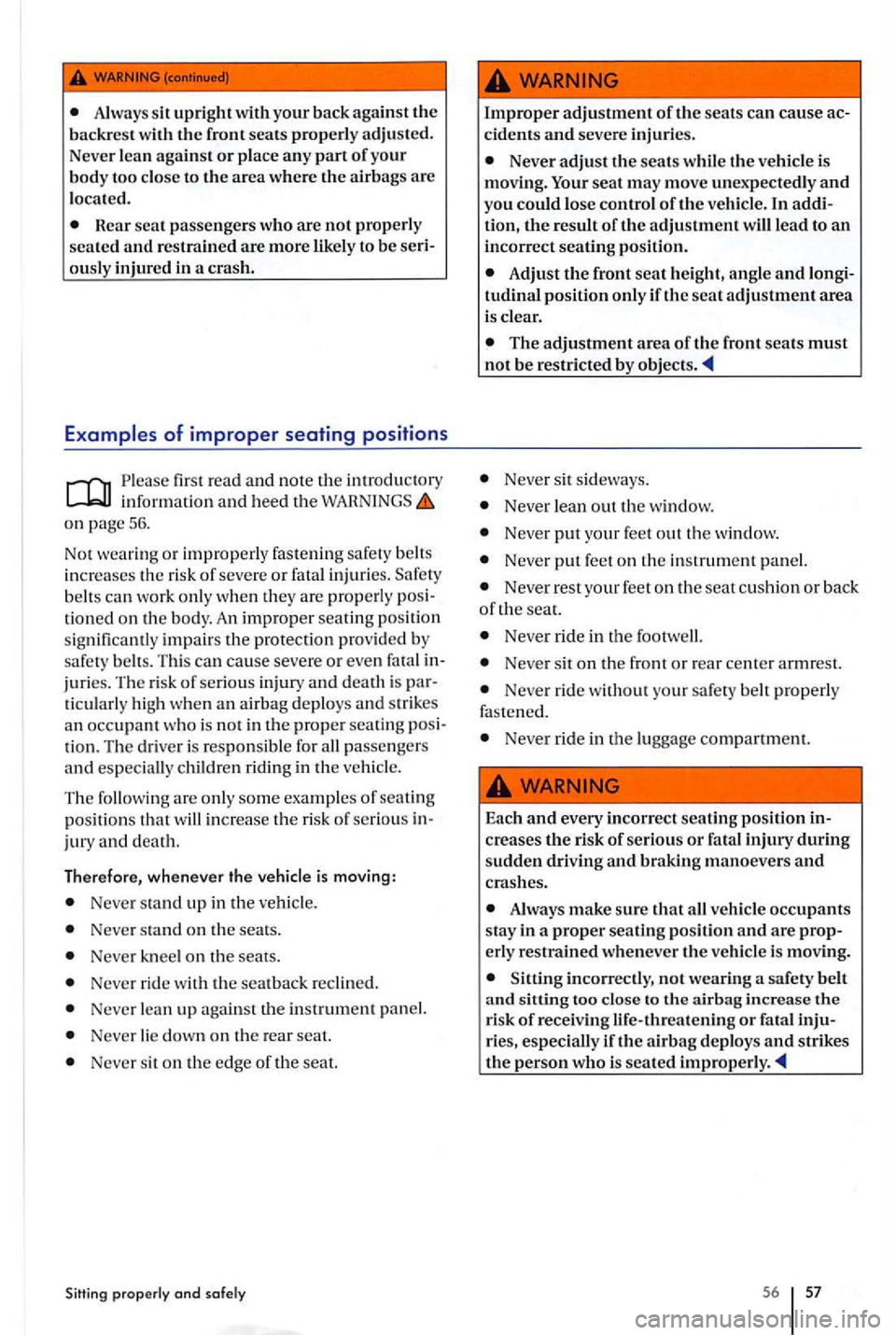
Always upright your back agains t the backrest with the front seats properly adjusted.
Never lean agains t or pla ce any part of you r
body too close to the area where the airb ags are
l oca ted.
Rear seat passengers who are not properly
seated and restrained are more lik ely to be seri
ously injured in a crash.
of improper seating positions
first r ead and not e th e introdu ctory inf ormation and hee d th e on pa ge 56.
Not w earin g or improperly fastening safety belts
i n c reases the risk of se ver e or fata l injuri es. Safe ty
b elt s can work onl y when they are prop erly po sitioned on th e bo dy. A n improp er se atin g pos ition
s ig nifi cantly impai rs the protection provided by
safety belt s. Thi s can cause se ve re or ev en fa ta l in
j uries. T he risk of se rious injur y and d eath is pa r
ti cularly hi gh wh en an airbag depl oys and strik es
an occupant who is not in the prop er seatin g pos i
ti o n. Th e driver is respons ibl e fo r pa ssen ge rs
a nd especi ally childr en riding th e vehicl e.
Th e
and dea th.
Therefore, whenever the vehicle
is moving :
Never stand up in the v ehicle .
Never stand on the seats.
Never kneel o n th e se ats.
Neve r rid e w ith the seat back re clin ed .
Neve r lea n up again st t he in strum ent pa nel.
Neve r lie dow n on the rear seat.
Neve r sit on th e edge of th e se at.
Sitting properly and safely
Improper adjustment of the seats can cause ac
cidents and severe injuries.
Never adjust the seats while the veh icle is
moving. seat may move unexpec tedly and
yo u could lose contro l of the vehicle. In addi
tion, the result of the adjustment will lead to an incorrect seating position.
Adjust the front seat height, angle and longi
tudinal position only if the seat adjustment area is clear.
The adjustment area of the front seats must not be restricted by ob jects
Nev er sit side ways.
N ever lean out the w indow.
Neve r put your feet o ut the window.
Never put feet on th e instrum ent panel.
Neve r rest your feet on the s eat cushion or b ac k of the seat.
Never rid e in the foo t well.
Neve r sit on th e front o r rea r ce nter armrest.
Neve r rid e withou t your belt prop erl y faste ned.
N ev er ride in th e lu gg age compartment.
Each
and incorrec t seating position in
creases the risk of seri o us or fatal during sudden driving and brakin g manoevers and cras hes.
Always make sure that all vehicle occupants
stay in a proper seat ing position and are prop
erly restrained whenever the vehicle is moving.
incorrec tly, not wearing a safety belt and sittin g too close to the airbag increas e the risk of receiving life-threatening or fatal inju
r ies, especially if the airbag deploys and strikes the person who is seated improperly
56 57
Page 63 of 541
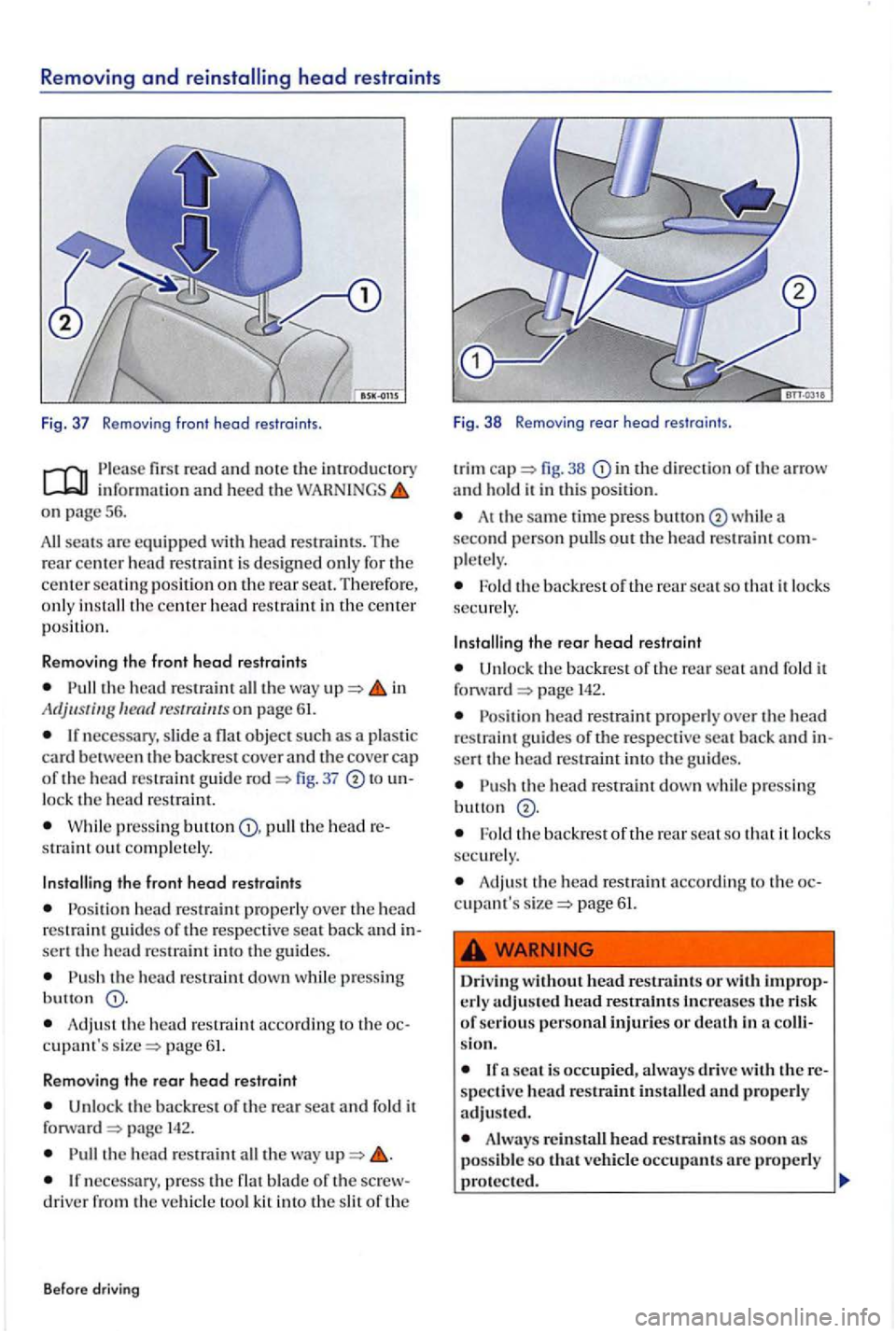
Removing and head restraints
Fig. 37 Removi ng fro nt head restr aints.
read and note the introduc tory informat ion and heed the on page 56 .
scats arc equipped with head restrain ts . The rear c e nt er h ead restrai nt is des igned onl y fo r the ce nter seat ing positi on on th e rear sea t. Th erefo re ,
o nl y
the head re straint the wa y in Adjustin g res traints on page 61.
necessary , slide object su ch a s a pla sti c
ca rd be tween the backre st cover and the co ver cap
of the head restraint g uid e 37
W hil e pres sing pull the head straint out compl ete ly .
the front head restraints
P o sition head restrain t prop erly ove r th e head
r e s tr ain t gu ides of th e respective seat back and sert the head rc s trai m into th e g uid es.
the hea d restraim down whil e pressin g
but to n
Adjust the h ead re strai nt acco rding to the c upant's page 61.
Removing the rear head restraint
Unlock the backrest o f th e re a r seat and fold it
f orward p age
th e head re straint th e wa y
necess ary, pre s s th e flat blade of th e drive r from th e ve hicle too l kit into the s lit of th e
B efore driving Fig
. 38 Remov ing r
ear hea d restra in ts .
trim in the direction o f th e arrow and hold it in thi s posit ion.
At th e same time press bullon second person pull s out th e head restraint
th e backrest of th e rear scat so that it lock s
secure ly.
the rear head restraint
Un lock the backrest of the re a r scat fo ld it
f o rward page 14 2.
h ead restraint prop erly ove r th e head restra int guides of th e re spective sca t back and sert the head restraint into the g uide s.
the head res traint down whil e p ressin g
Fold the backres t of the rear seat so that it lo cks secure ly.
Adju st th e head re straint a ccord in g to the page 61.
Driving without head restraints or wit.h crly adjusted head restra .lnts Increases the ri sk of seriou s personal injuries or death in co
scat is occupied, always drive with
Always reinstall head r estraints as soon possib le so that veh icle occupan ts properl y
Page 65 of 541
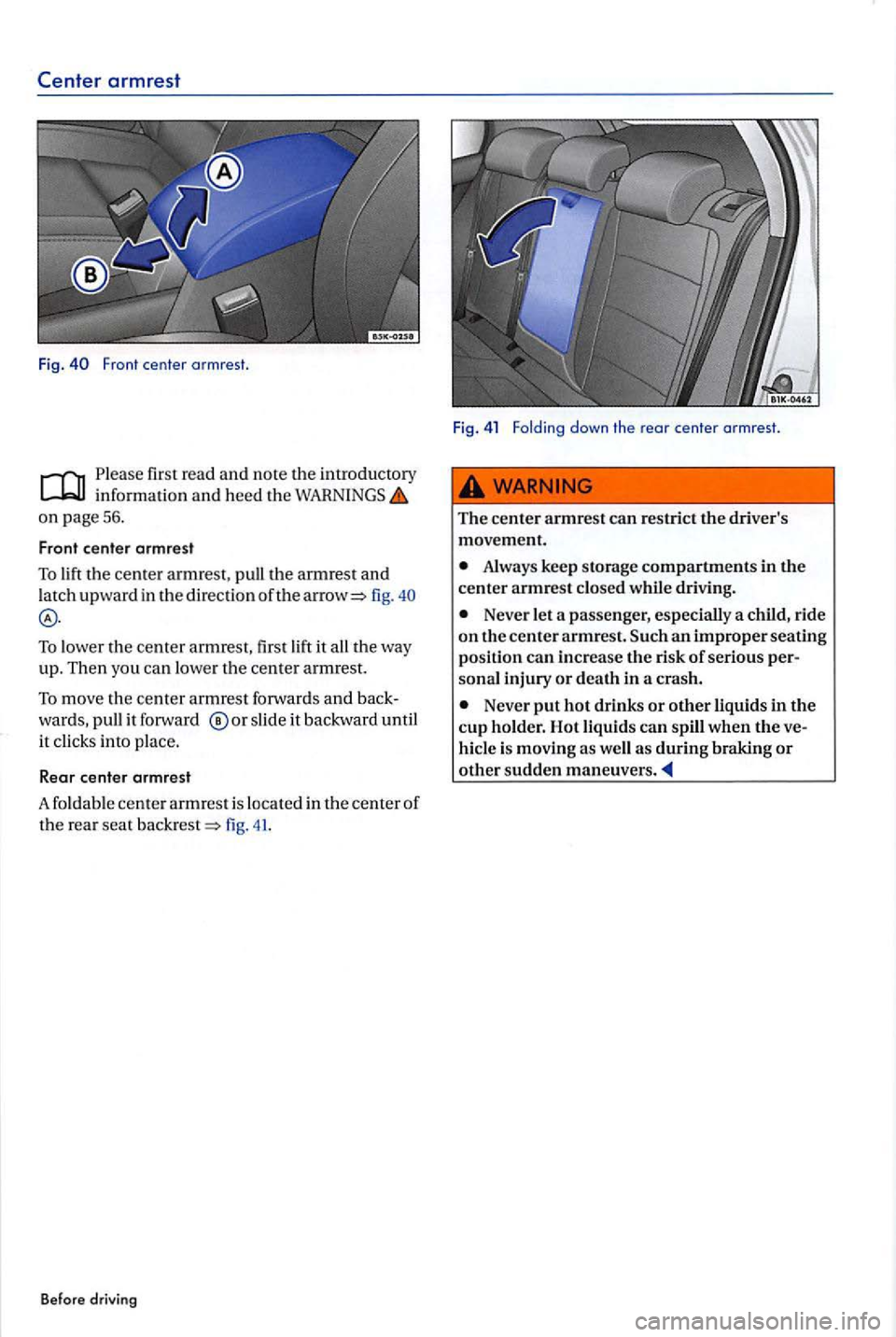
Please fir st read and note the in tro ductory
on page 56.
Front center armrest
To lift the cente r a rm rest, pull the armrest and
l atc h upward in th e direction of the fig.
To lowe r th e center armre st, first lift it all the way up. Then you ca n lowe r the center armre st.
To move the center armrest forwards and back
wa rds, pull it forwa rd slid e it backward until
it click s into place.
Rear center armrest
A foldabl e ce nter armrest i s loca te d in the center of the rear sea t fig. 41.
Before drivi ng Fig
.
41 Folding d own th e rear center armrest.
The center armrest can restrict the driver 's
movement.
Always keep storage compartments in the center armrest closed whil e driving .
Never let a pas se nger, esp ecially a child , ride on thecenterarmrest. an improper seating position can increas e the risk of se rious personal injury or death in a cras h.
Never put hot drinks or other liquids in the cup h old er. Hot liquid s can spill wh en the ve
hicl e is moving as well as during braking or other sudden maneuvers.
Page 69 of 541
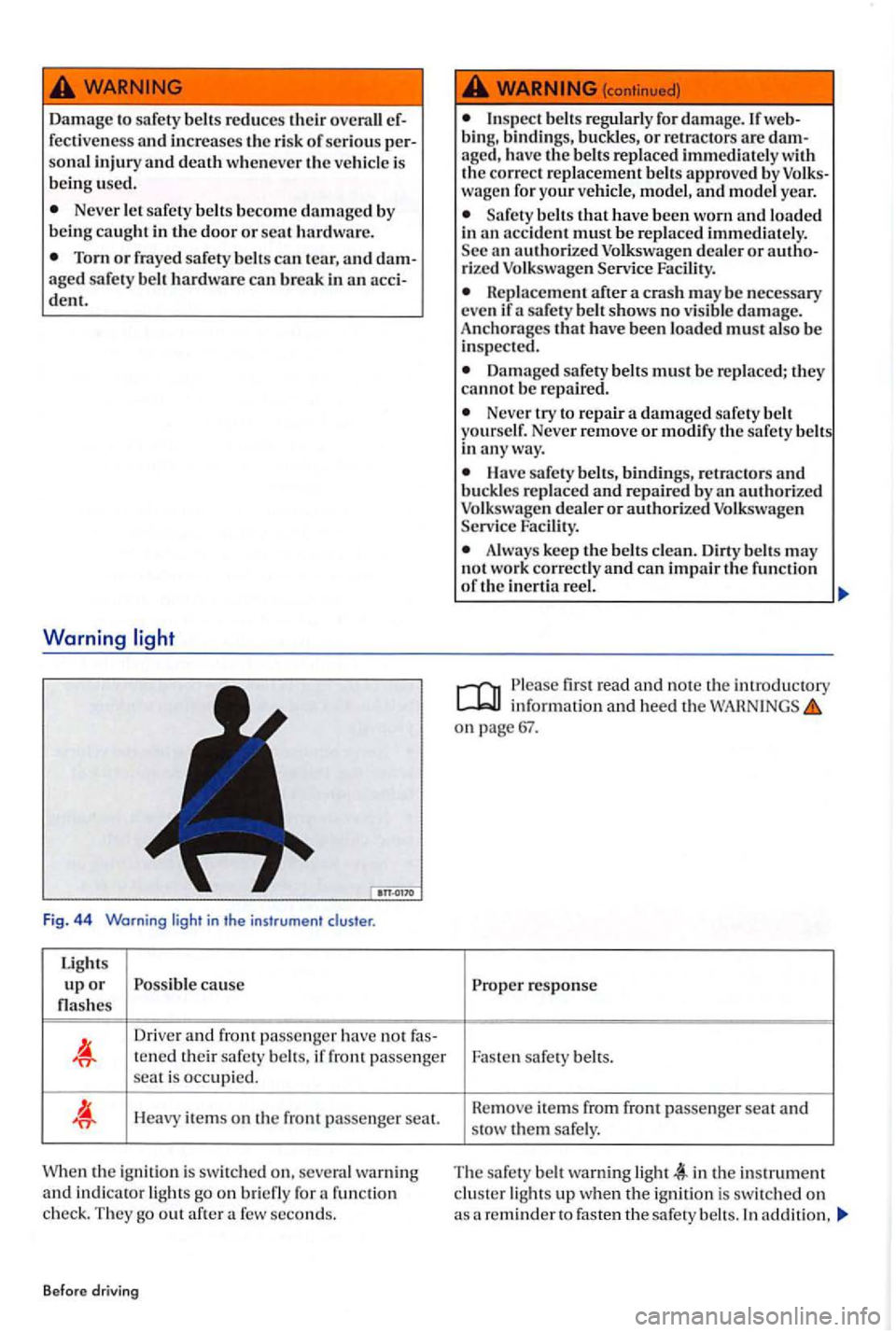
Damage to safety belt s reduces their ef
fectiven ess increase s the ris k of seriou s perinjury is
b ein g used.
Neve r safety belt s beco me damage d by
b ei ng caught in the door or seat hardware.
Torn or frayed safety te ar, and dam
aged safety hardware break in accident.
Warn ing
Fig. 44 Warning
Light s
u p o r cause
Driver and fron t pa sse nger have not fas-te n ed their safety if fron t passenger
sea t is occupied.
H eavy items on the front passenger seal.
the ignition is switched on. warning and in dica tor go on fun ction c he ck. They out after few seconds.
Before driving
for damage. If web
bin g, bindings, or re tra cto rs are damaged, have the approve d by wage n for your and year .
Safety that have bee n worn and in an accide nt must be
after a cras h may be nece ssary
eve n if safety sho ws no damage.
Anchorages that have been must
Damage d safety the y canno t b e re p air ed.
Neve r try to re pair a damage d sa fety Never remove or m odify th e safety
Have sa fety belts, binding s, retractor s and
or authorized Serv ice
k ee p the may
n ot work correct ly and ca n impair the function
o f th e in erti a
firs t rea d and note the introductory information and heed the on page 67.
Proper respo nse
Faste n safe ty
T he safety warning in the instrument
In add ition,
Page 78 of 541

the colli sio n to help prot ect a n unrestrained front
sea t occ upa nt. The airba g m ay then not pro vide
e nou gh protection fo r an occ upant not wearin g a
s af ety be
lt.
u sc th e safety belt ex te nd er ap proved by Volkswag en for you r vehicl e.
Safety belt extenders offer optimum protec
tion onl y w hen they are prop erl y used.
A driver or passe nger wh o is not properl y
re strain ed ca n be seriou sly injured by strikin g
th e interi or o f t he passe nger compartment or by the s afety be lt itse lf, w hich can be displac ed fro m stron ger parts of the body int o se nsitiv e
area s lik e the abdomen.
usc the extender when the belt is not
lon g eno ugh t o be worn low and snug and th e person is in the correct sea ting po sition . R e m o
ve an d stow extender sa fe ly w hen no t needed.
Never usc the safety belt extender if you can prop erl y attach the safe ty be lt wit hout it. safety belt ex tender when not n eeded can crease the risk of inju ry, especiall y in a co llision.
Never use safety belt ex tender if the dis
tan ce (B ) between the front ed ge of the safe ty
b elt exte nd er buckle (A) and th e ce nterlin e of the perso n using the safety belt exte nde r= page 76, fig. 56 © is less than 6 in ches (15 em ).
Never leave an unused safe ty belt exte nder in the belt bu ckl e. Remo ve and stow the sa fety belt
ex te n d er safely wh en no t n eeded.
Sitti ng p roperly and safely
Always make sur e that the tongue of the
sa fety belt extender is securely inserted into the buckle for the seating position that belongs to
th e sca t where the safety belt extende r i s being
u se d. Attaching the safety belt to th e wrong
bu ckle will reduc e safety belt effec tive ness and can cause se rious perso nal injury.
Never usc more than one sa fe ty bel t extende r
w it h a safety belt. more than on e safety
b elt extender can change the way the sa fety
belt passes over the body a nd can cause seriou s
injury.
Never use the safety be lt ex tender to secure
a child restrai nt.
Never use a sa fety belt ex tend er on your
Neve r usc the safety belt ex tender you ob
t a in ed for your vehicl e for any other ve hicle,
regardless of m ake , model , or model year.
Note
Leaving the extender attached to the s afety be lt buck le when the front seat i s occ upied an d the safe ty belt is not being used w ill sig n al t o th e
a irbag control unit that the fron t passenger sea t
i s occupied and that the saf e ty be lt is be ing used. The electron ic contro l unit for th e a ir b ag system
will the n r eceive incorrect information that will
- ca use th e sa fety belt prete n sioner to deplo y unnecessarily in colli sion s and -ca use the front passe nger airb ag to dep loy
later in colli sion s in whic h th e front airba g
wo uld otherwise be triggered earlier to help
protec t a n unrestrain ed fron t sea t passe nger.
A pre te nsioner that has deployed cannot be p aired. The e ntire safety belt must be replaced.
! Note
If the safety belt extender is left atta ch ed to the
safe ty belt buckle, the safety belt warni ng sys te m
w ill sense that the sa fe ty be lt fo r th at seat is being
used . The w arning light will not come on and th e warning chime will not sound even though the
s cat is occ upie d and the safety belt is not b eing u sed.
76 77
Page 82 of 541
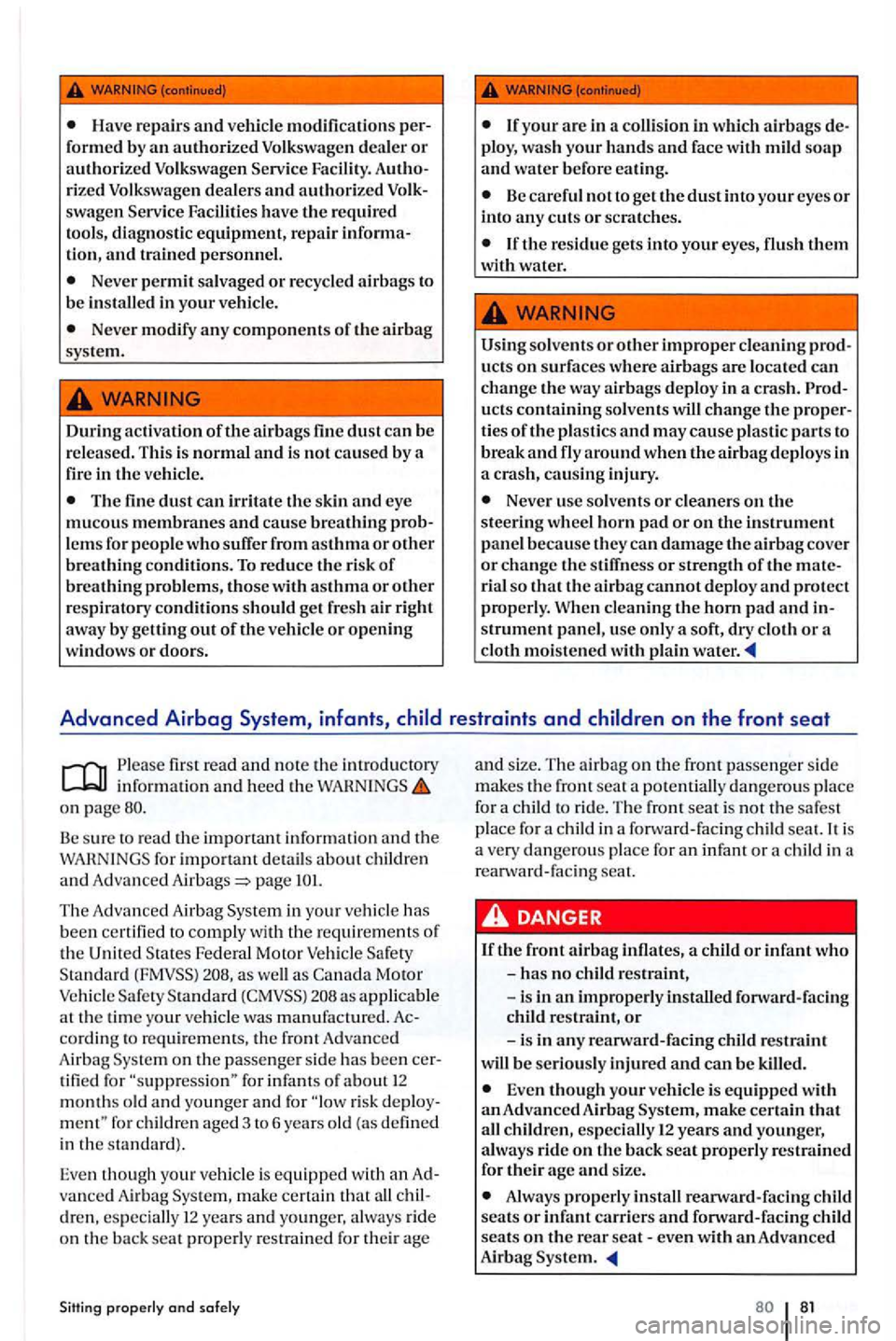
Have repairs and vehicle modification s
rized Volkswagen dealers and authorized swagen Facilities have the required
tool s, dia gnostic equipment, repair tion, and trained personnel.
Never permit salvaged or recycled airbags to be installed in your veh icle.
Never modify any components of the airbag syste m.
During activation of the
The fine dust can irritate the skin and eye muco us membranes and cause breathing lems for people who suffer from asthma or other breathin g conditions. To reduce th e risk of breathing probl em s, those with asthma o r o th er
r es piratory
Be careful no t t o ge t the dust into your eyes or
into any c uts or sc ratches.
Using so lve nts or other improper cleaning
u cts containing so lvents w ill ch ange the ti es of the plastic s and may cause plastic parts to break and fly around when the airbag deploys in a crash, causin g injury.
Never usc so lven ts or cleaners on th e
s teering wheel horn pad or on the instrument pan el b eca use they ca n damage the airbag cover or change the s tiffness or strength of the rial so that the airba g cannot deploy and protect properly. When cleaning the horn pad a n d strument panel, use onl y a soft, dry cloth or a
cloth moistened w ith plain water.
Please first read and note th e introductory informatio n and heed the WARN INGS on
Be sure to read the important inform ation and th e for important detail s about child ren
and Adva nce d Airbags
in you r ve hicl e has
been ce rtifi ed to comply wit h th e requirement s of the Unit ed Federal Moto r Vehicle as well a s Motor Vehicl e as a pplicabl e
at the time your vehicle was manufactured. co rding to req uirement s, th e front Advance d
A ir bag on th e passeng er side h as been tified for for infant s of about 12
months old and you nger and for risk for ch ildren aged 3 to 6 yea rs old {as defined
in the stand ard ).
Even th ough your vehicl e is equipp ed w ith an vance d Air bag mak e ce rtain that all dre n, es pecially 12 years and younge r, a lways ride
o n th e back seat properly restra ined for their a ge
Sitting properly and safely
and size. The airb ag on the front passenge r side m ak es the fron t seat a potentially dangerou s pla ce for a child ride. Th e front seat is no t th e sa fest
p lace for a child in a fo rward -faci ng chil d seat. is
a very dangerous place for an in fant or a child in a
r earward-fac ing sea t.
is in an improp erl y in stall ed for ward-faci ng
child res traint, or
in an y rearward- facing child restraint
will
be se riously injur ed and can be kill ed.
Eve n though your vehicl e is equipped with an Advance d Air bag make certain that aU children, especia lly years and you nger,
a lwa ys rid e o n the back seat properly restrained
for their age and s ize.
Always properly install reanvard-facing child seats or infant carriers and forward -faci ng c hild
s eats on the rear seat-even with an Advanced
81
Page 90 of 541
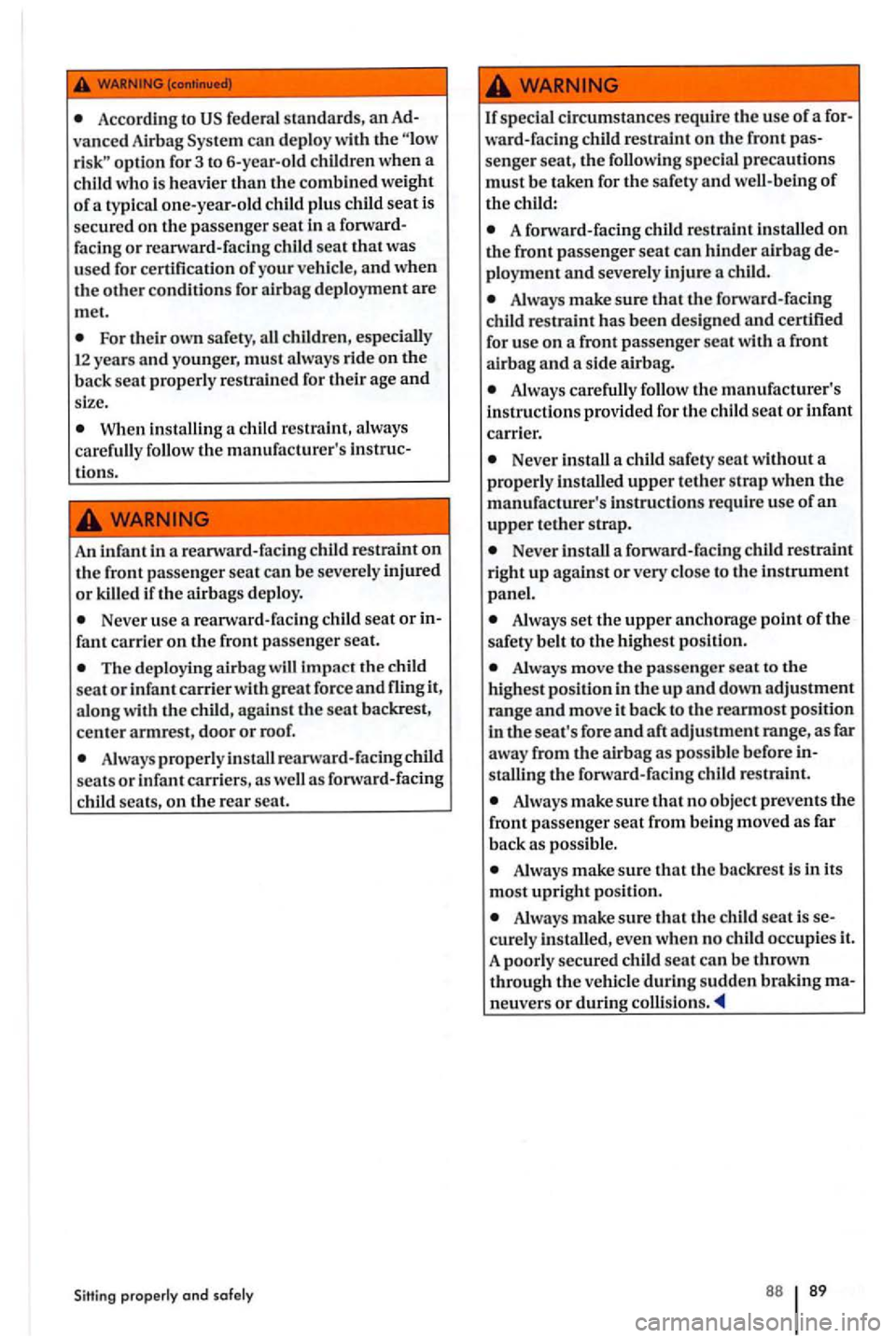
According to US federal stand ards , an vanced Alrbag System can deploy with the
For their own safety, all children, especially 12 years and younger, must always ride on
When installing a child restraint, always
carefully follow the manufacturer's instruc
tion s.
An infant in a reanvard-facing child restraint on the front passenger seat can be seve rely injured or killed if the airbags deploy.
Never use a reanvard-facing child seat or
The deploying airbagwill impact the ch ild
seat or infant carrier with great force and fling it,
along with child, against the seat backrest,
center armrest, door or roof.
Always properly reanvard-facingchild
sea ts or infant carriers, as well as fonvard-facing
child seats, on
ond
If special circumstances require the use of a
senger seat,
A forward-facing child restraint installed on
ploym ent and severely injure child.
Always make sure the fonvard-facing
child restraint has been designed and certified
for use on a front passenger seat with a front
airbag and a side airbag.
Never install a child safety seat without a
properly installed upper tether strap when the
manufacturer 's instructions require use of an upper
Never install a fonvard-facing chil d restraint
right up
Always set the upper anchorage point of the
safety belt to the highest position.
Always move passenger seat to
rearmost position in seat's fore and aft adjus tment range, as far
away from
stalling
Always make sure that no object prevents tJ1e
front passenger seat from being moved as far
back as possible.
Always make sure that the backrest is in its
mo st upright position.
Always make sure that the chil d sea t is curely installed, even when no child occupies it.
A poorly secured child seat can be thro wn
through the vehicle during sudden braking
88 89
Page 93 of 541

Always make sure nothing is in the front airbag deploym ent zone that could be struck by the airbag when it inflates.
Never hold things or on your lap when the vehicle is in use.
Never place accesso ries or other objects
(such as cup holders, tel ephone brackets, note pads, navigation systems, or things that are large, heavy, or bulky) on the doors; never attach them to the doors or the windshield; never place th em over or near or attach them to the area marked
fig. 59 or 91, fig.
Never attach objects to the windshield above the passenger front airbag, such as accessory navigation units or music player s.
Never recline th e front passenger seat to transport objects. can also move into the deployment area of the side airbags or the front airbag during breaking or in a sudden maneuver. near th e a irbags can fly dangerously through the pass enger compartment and cause injury, particularly when the seat is reclined and the airbags inflate.
Always make sure that there is nothing on the front passe nger seat that will cause the weightsensing mat in the scat to signal to theAirbag that the scat is occupied by a person when it i s not, or to signal that it is occupied by someone who is heav ie r than the person actually
sitting on th e sca t. The weight of th e object could cause the passenger front airbag to be turned on when it should be off, or could cause the airbag to work in a way that is differ ent from the way it
would have worked without the added weight.
Alwa ys make sure that nothing is on the front passenger seat when the backrest is folded
forward. Even light objec ts could be pushed into the seat cu shi on and cause th e weight-sensing mat in the seat to re gister enough weight to turn the airbag on.
Never usc solvents or cleaners on the steering wheel horn pad or instrument panel, because they can damage the
Before driving
airbag cover or change the stiffne ss or strength of the material so that the airbag cannot deploy and protect properly. When cleaning the hom pad and instrumen t p anel, use only a soft, dry cloth or a cloth moist en ed
with plain water.
A front seat passenger, especially an infant or small child, will be seriously injured and could
eve n be killed if he or she is
Although the Advanced Airbag has been designed to switch off when an infant or child is on the front passenger seat in a child seat that was used during the certification
process for the Advanced Airbag no one can guarantee with absolute certainty that the airbag never deploy under these particular conditions in all conceivable situations for the duration of the vehicle 's use.
For their own safety, all children, especially those 12 years and younger, mus t always sit on the back seat, properly restrained for their age and size.
Facility. A lit indicator light means the airbag may not work properly if
activated in a crash.